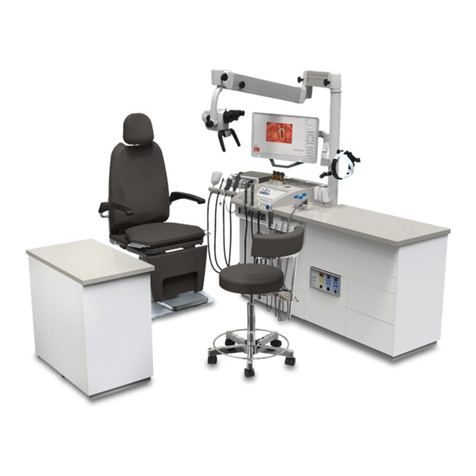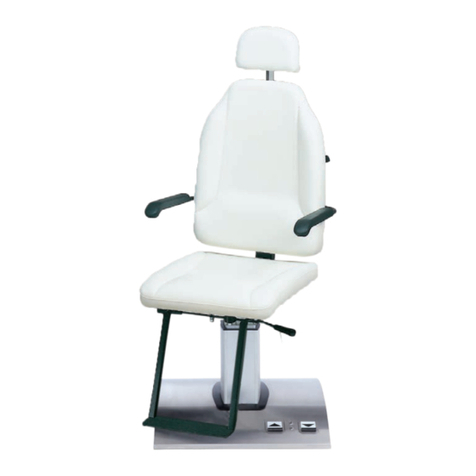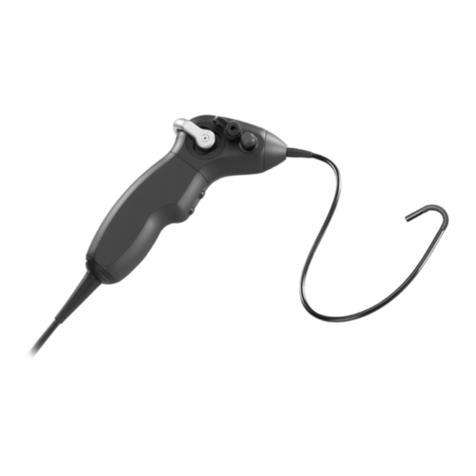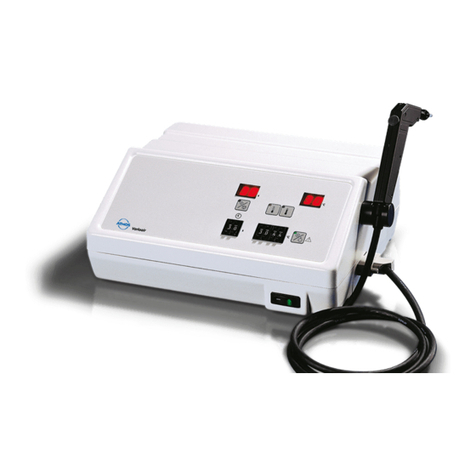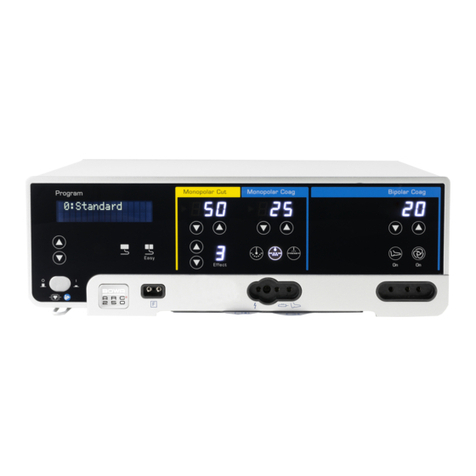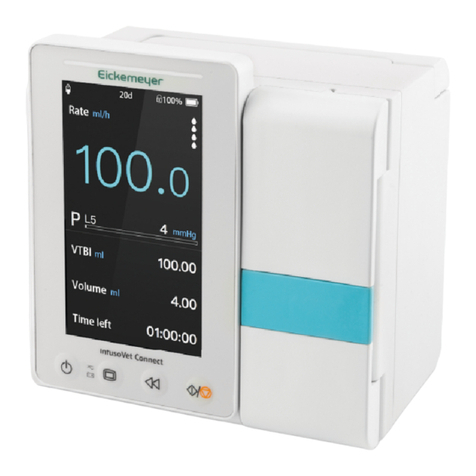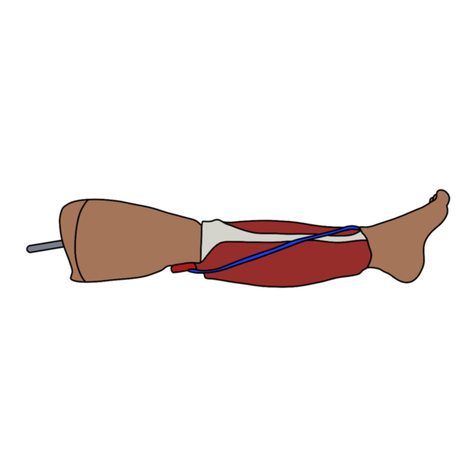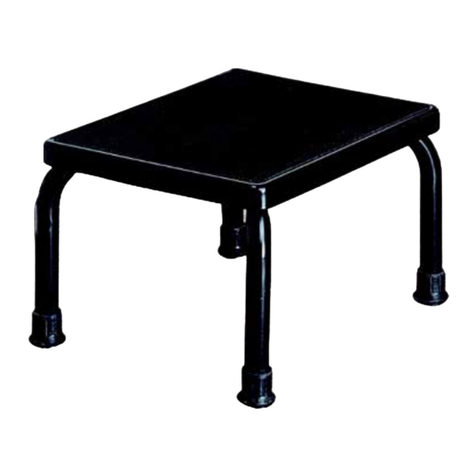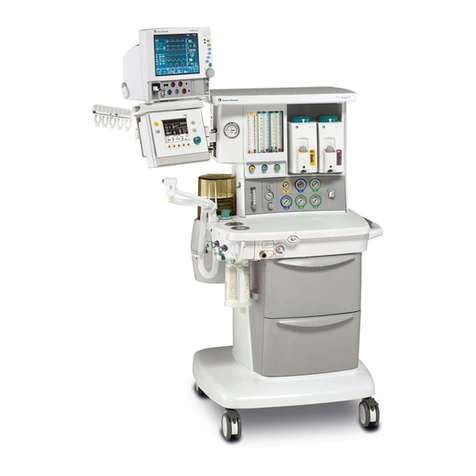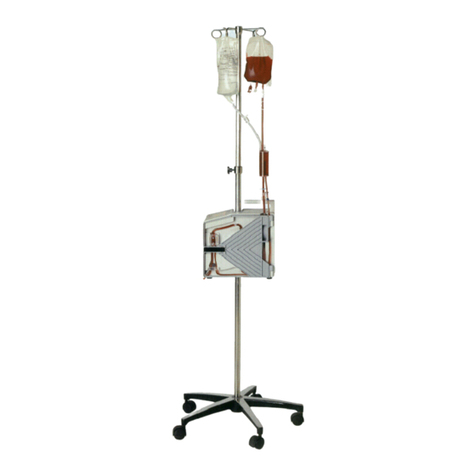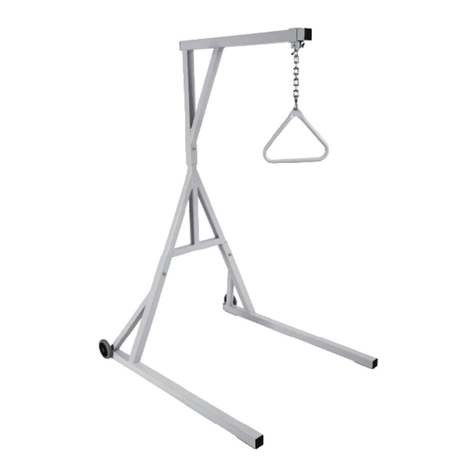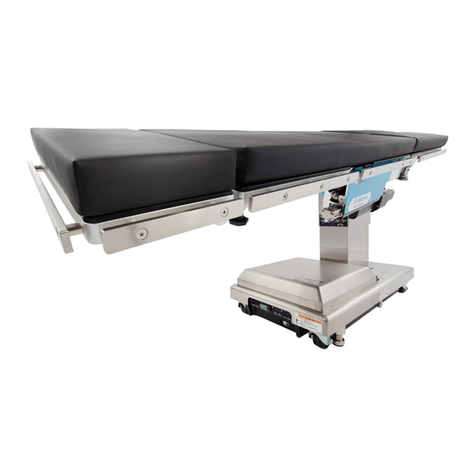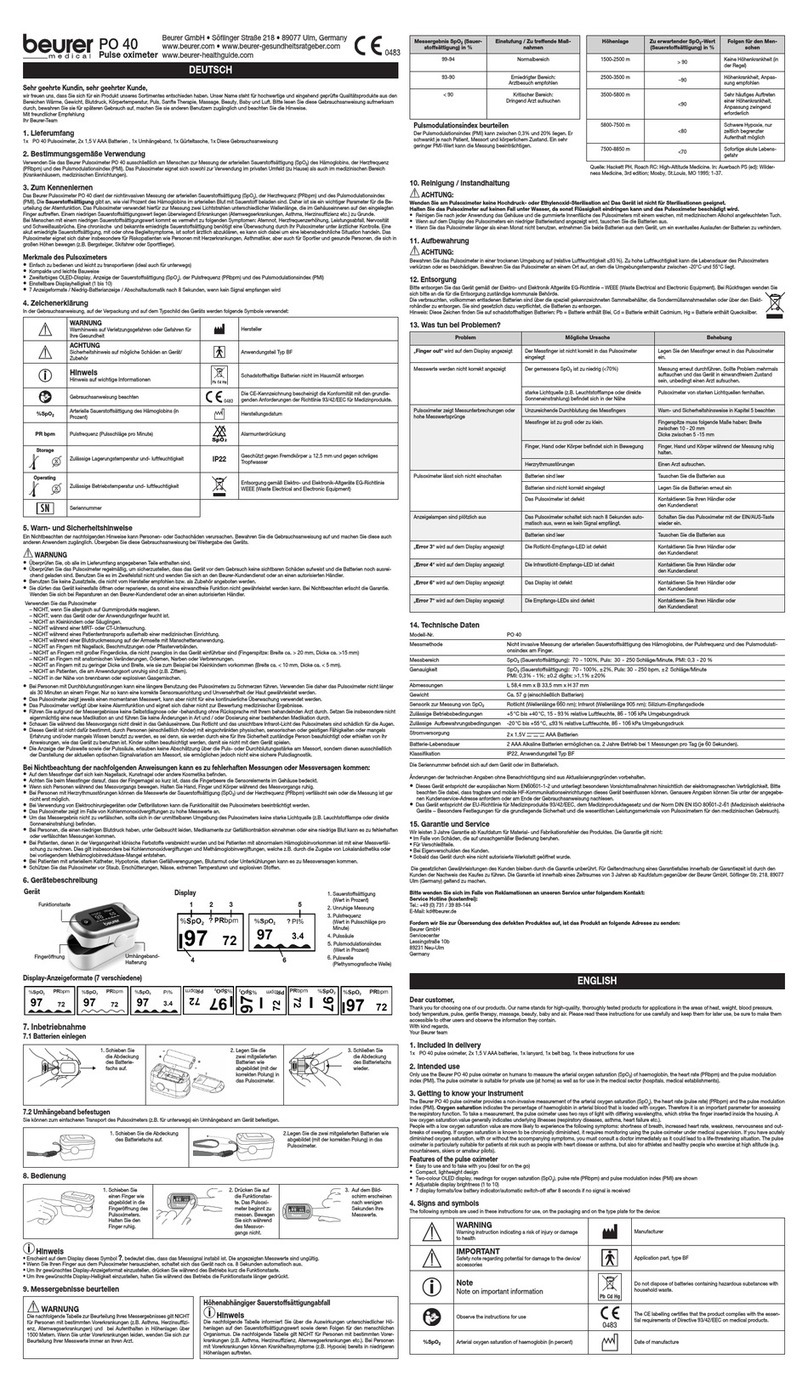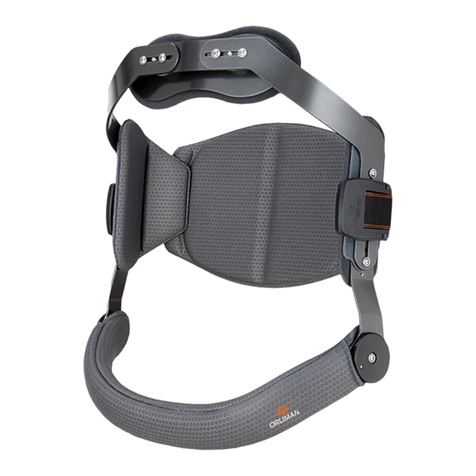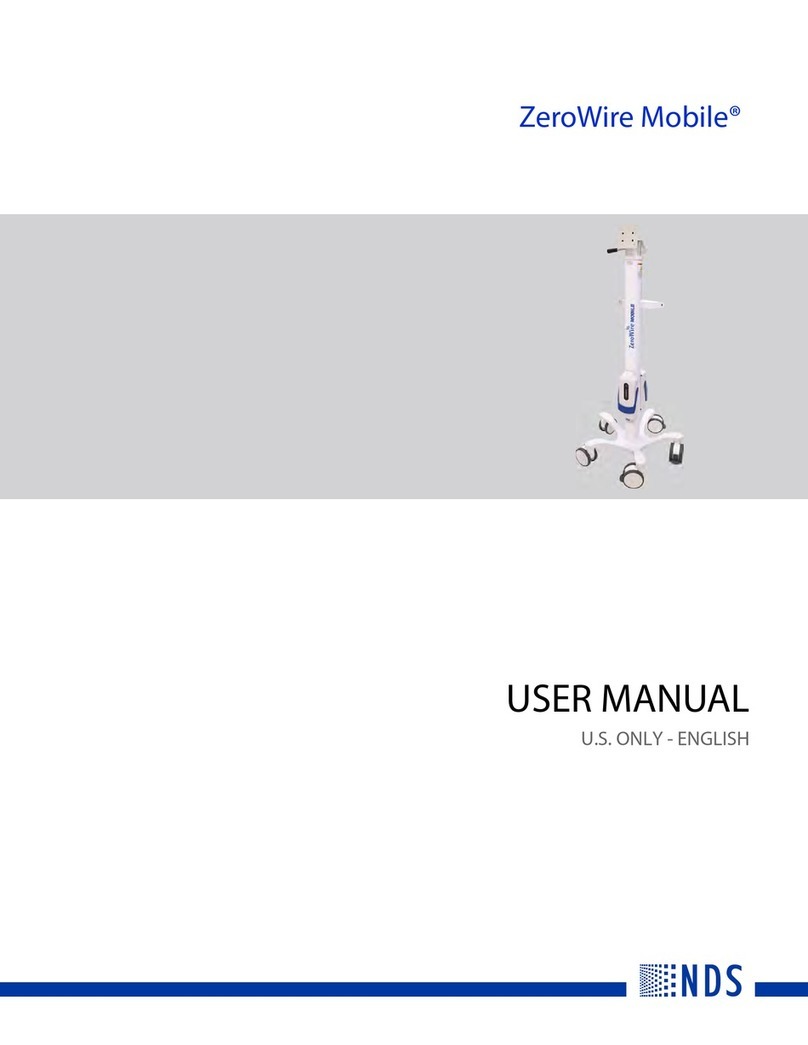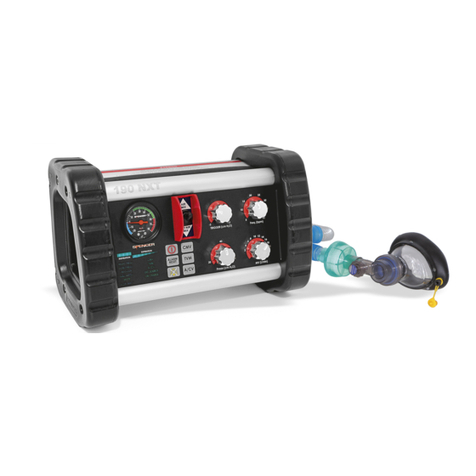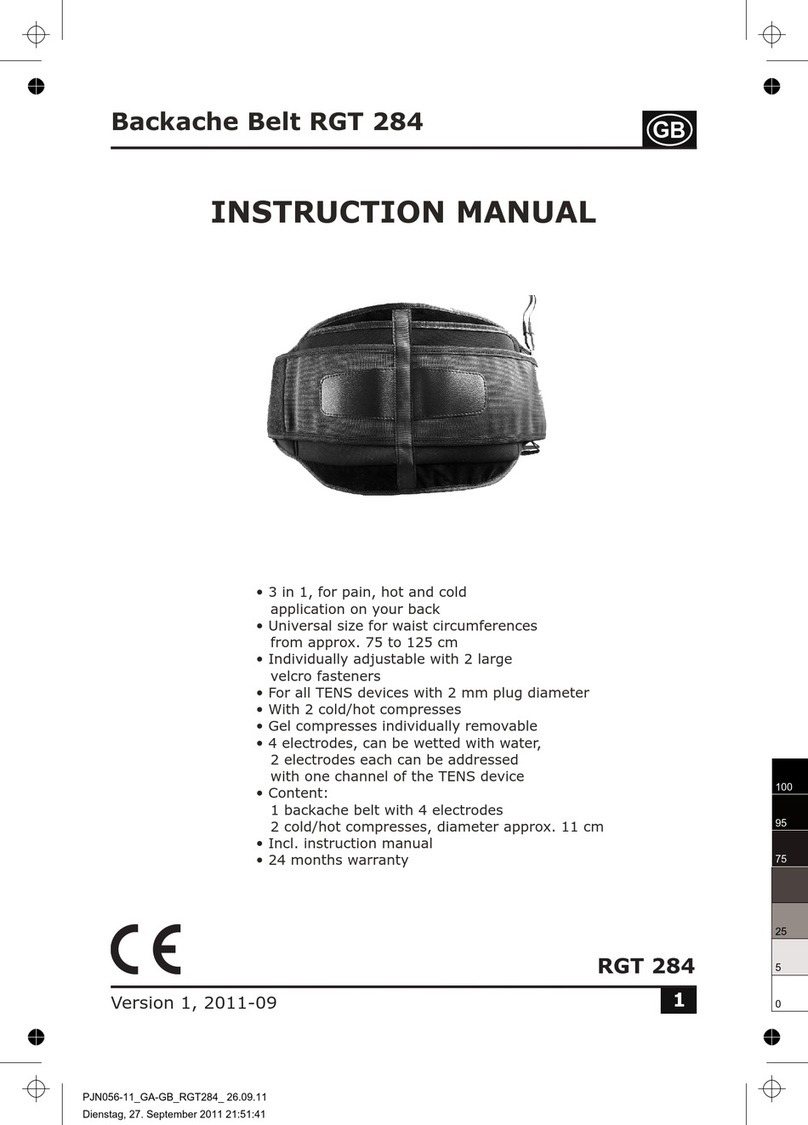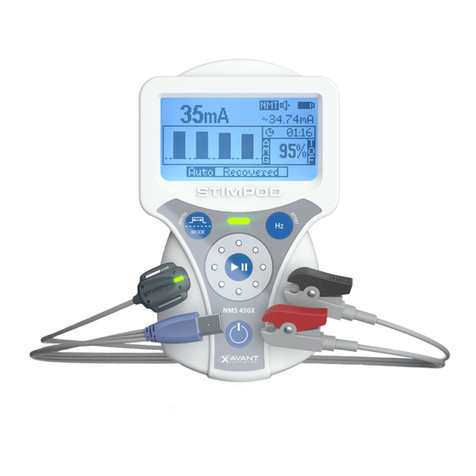Atmos E 1 User manual

MedizinTechnik
ATMOS®Chair E 1
GA1GB.130203.0
2019-06 Index: 07
Operating Instructions
English

2
Further information, accessories, consumables and spare
parts are available from:
ATMOS
MedizinTechnik GmbH & Co. KG
Ludwig-Kegel-Straße 16
79853 Lenzkirch
Deutschland / Germany
Phone +49 76 53 689-0
Fax: +49 76 53 689-190
+49 76 53 689-493 (Service Centre)
www.atmosmed.de
Table of contents
1.0 Introduction.........................................................3
1.1 Notes on operating instructions ............................3
1.2 Intended use .........................................................3
1.3 Function ................................................................3
1.4 Explanation of pictures and symbols ....................4
1.5 Scope of supply ................................................... 5
1.6 Transport and storage...........................................5
2.0 For your safety....................................................6
3.0 Setting up and starting up .................................7
3.1 Setting up..............................................................7
3.2 Starting up.............................................................7
3.3 Electrical connection.............................................8
4.0 Operation.............................................................9
4.1 Positioning the patient...........................................9
4.2 Adjusting the seat height.......................................9
4.3 Rotating the upper part of the chair ....................10
4.4 Adjusting the backrest.........................................10
4.5 Adjusting the arm rests .......................................10
4.6 Adjusting the head rest .......................................11
4.7 Foot rest............................................................. 11
4.8 Chassis (optional) .............................................. 11
5.0 Cleaning and care.............................................12
5.1 General information on cleaning and
disinfection..........................................................12
5.2 Cleaning and disinfection of the device
surface and upholstery........................................12
5.3 Recommended surface disinfectants..................13
5.4 Recommended upholstery disinfectants.............13
6.0 Maintenance and Service.................................14
6.1 Replacing the fuse ..............................................14
6.2 Sending in the device..........................................14
7.0 Troubleshooting................................................14
8.0 Accessories and spare parts...........................14
8.1 Accessories.........................................................14
8.2 Spare parts .........................................................14
9.0 Technical data ...................................................15
10.0 Disposal ..............................................................16
11.0 Notes on EMC.....................................................17

3
1.0 Introduction
1.1 Notes on Operating Instructions
These operating instructions contain important notes on how to operate the ATMOS®Chair E 1 safely,
correctly and eectively. Their reading helps to avoid risks, and also to reduce repair costs and down-
times. This increases, amongst other things, the reliability and service-life of the device.
These operating instructions serve not only for new operating personnel to be instructed in its use, but
also for use as a reference manual. Reprints (also in extracts) only with permission in written form by
ATMOS.
These operating instructions must always be kept available near the device.
Care and period tests in conjunction with professional execution provide for operational safety and
readiness for use of your ATMOS®Chair E 1 and are therefore a must besides regular cleaning.
Repair work and period tests may be carried out only by expert personnel authorised by ATMOS. By
applying only original spare parts you will have the guarantee that operational safety, readiness for work
and the value of your ATMOS®Chair E 1 will be preserved.
• The product ATMOS®Chair E 1 bears CE marking according to the EC Directive of the council for
medical products 93/42/EEC and meets the basic requirements of Appendix I of the directive.
• The product ATMOS®Chair E 1 complies with all applicable requirements of the Directive 2011/65/EC
restricting the use of certain hazardous substances in electrical and electronic equipment (“RoHS”).
• The declaration of conformity and our general standard terms and conditions can be obtained on our
website at www.atmosmed.com.
• The quality management system applied at ATMOS has been certied according to international
standards EN ISO 13485.
• Prior to start-up please peruse chapter 2.0 „For your safety“, in order to be prepared for any possible
dangerous situations.
1.3 Function
The electrically height adjustable ATMOS®Chair E 1
patient chair has been designed for medical examinations.
Height adjustment is achieved by an encapsulated innitely
variable electric actuator. The removable headrest is also
height adjustable. The moving and fold away armrests will
maintain a horizontal orientation even if the backrest is
being reclined to horizontal. Upper part rotates around 360°
via a ball bearing and is equipped with an arrestor each 90°.
The height adjustment is controlled by a foot switch. The
mechanically reclining backrest ranges from +7° (forward
lean) to horizontal, the footrest features a fold away foot
plate.
Options: Chair is moveable to any direction on 4 freely
swivelling castors (see options)
1.2 Intended use
Name: ATMOS®Chair E 1
Main function: This patient chair enables the optimum
positioning of the patient with regard to height and access.
Medical indications / application:
• Positioning of the patient during standard ENT
examinations and / or therapy.
• Specication of the main function:
• Electrical height adjustment via foot switch from 52.0 cm
up to 72.0 cm
• Upper part of the chair 360° rotatable and can be
arrested at 90°
• Innitely variable inclination of the backrest from +7°
forward to the horizontal position
• Height adjustable and detachable headrest
• Armrests can be folded up (individually)
• Foot support, can be swivelled synchronously with the
backrest
Application organ: Positioning of the patient
Application time: Temporarily (max. of 60 minutes)
Application site:
In clinics and practices for ENT doctors and phoniatricians.
The application of the doctor’s chair must be executed by
medically trained persons only.
Contraindications: None
The product is: X active □ not active
Sterility: Not necessary
Single-use product / reprocessing: No single use product

4
1.4 Explanation of pictures and symbols
1.0 Introduction
!
■
●
→
Graphic symbols contained in these operating instructions
Warning, special diligent notice
Short cuts / symbols contained in these operating instructions
Please press where dot
indicates
Subnumeration
Numeration
General information
Follow the arrows
Replace
Check
Please read, important
information
Move, plug... in this
direction
Engage, check
correct t
Turn, shift ... in this
direction
)Important information
Symbols of ATMOS®Chair E 1
Order number
This product complies with the relevant
requirements of EU Directive
Degree of protection type B
REF
Replace
click

5
1.5 Scope of supply
• Prior to dispatch, the ATMOS®Chair E 1 was subjected to an extensive functional test and was carefully packed.
Nevertheless, please compare the contents of the shipment on completeness immediately upon receipt (see delivery note).
Basic device
Operating
Instructions
1.6 Transport and storage
• After the transport of the device in temperatures below
0°C or prior to rst start up it should be kept at room
temperature for at least six hours. If the device is not
acclimatized it may not be used as damages to the
electronic components may be the result.
• Only transport the device in a shipping carton, which is
padded and oers sucient protection.
• If damage occurs during transport:
- Document and report the transport damage.
- Send the device to ATMOS (Chapter „6.2 Sending in
the device“ on page 14).
Ambient conditions:
Transport / storage: -10...+50°C;
30...95 % air humidity without
condensation
at an air pressure of
500...1060 hPa
Operation: +10..+35°C;
30...95 % air humidity without
condensation
at an air pressure of
500...1060 hPa
Power cable
1.0 Introduction

6
!
For your safety
2.0 For your safety
• Prior to starting the chair for the rst time, check whether
the supply voltage indicated on the line voltage selector
corresponds to the value of your local mains supply.
• For mains supply, only use the power cable supplied (or
an equivalent one).
• Check proper assignment when assembling country-
specic connections:
- green / yellow: protective conductor
- blue: neutral conductor
- black or brown: phase
• Prior to rst starting up, all connecting leads must be
checked on damage. Defect cables must be replaced.
• To disconnect the chair from the mains supply, rst
remove the plug from the safety connection socket.
Then disconnect the connection line from the chair.
Never touch plug or line with wet hands.
• Please observe the ambient conditions stated in the
technical data (chapter 9.0).
• The ATMOS®Chair E 1 is not designed for the use in
medical areas with an explosion hazard. Explosion-
hazardous areas may be caused by the use of
ammable anaesthetics, skin cleansing products and
skin disinfectants.
• Ensure that your patient sits in the middle of the seat.
A constant unilateral strain on the seat can damage the
surface.
• The user must be familiar with the operation of the chair.
• ATMOS is not liable for personal injury and damage to
property if
- no original ATMOS parts are being used,
- the advice for use in these operating instructions is
not being observed.
• The correct installation and handling of the device is
essential for safe operation. Therefore prior to starting
up you must become thoroughly familiar with the
contents of these operating instructions.
• The electric motor is protected by an integrated thermo
protection switch. After 1.5 minutes of continued
operation, the motor needs a cool down period of
approx. 8.5 minutes. If the thermo protection switch
activates, the motor needs a cool down period of
approx. 20 minutes.
• The device may not be operated:
- in explosion-hazardous areas
- in humid areas
• In case of malfunction or abnormal noises, immediately
disconnect the power plug. In such a case please
contact our service department
• The device may only be used for the purpose
described.
• Please note:
A medical insulating transformer with earth leakage
monitor or any similar safety system acc. to EN 60601-
1 is required, if several devices are connected over
one common power supply. The transformer must
correspond to the power consumption of all the devices
to be connected.
• The ATMOS®Chair E 1 has been designed in
accordance with IEC 601/ EN 60601. The equipment
conforms to VDE Safety Class I and must only be
connected to a properly installed earthed socket.
• The Chair may only be used under supervision (IEC
60601-2 / EN 60601-1).

7
3.0 Setting up and starting up
3.1 Assembly
• Always place the device on a level, safe surface.
3.2 Starting up
• Position the chair at the allocated space. Any oor
unevenness must be compensated for.
• Check that the upper part of the chair can rotate freely.
• Peruse safety information in part 2.0 prior to starting up
the device for the rst time.
• Finally, connect power cable.

8
3.3 Electrical connection
The ATMOS®Chair E 1 is supplied with a power cable and
IEC connection. Insert the power cord to the IEC socket at
the back side of the chair base and the wall mounted power
outlet.
Make sure, power outlet features a proper ground
connection.
The electrical connection values (voltage and nominal
frequency) as well as the data for fuses can be found on the
type plate above the connecting socket.
To disconnect the device, pull the mains plug out of outlet
socket.
)There is no indication that the device is powered!
)Disconnect chair, if not in use, during service and repair
work and or for cleaning.
3.0 Setting up and starting up

9
4.0 Operation
The height adjustment is controlled via the two foot switch
buttons marked with arrows. The left foot switch button is
for the upwards movement, the right for the downwards
movement.
The arm rests can be folded backwards; that makes it
easier for handicapped persons to be transferred from the
wheelchair to the examination chair.
The backrest inclination can be controlled by means of the
control elements attached to the side of the backrest.
Arm rests, foot support and backrest are coupled for
synchronous movements.
The electric motor is protected by an integrated thermal
protection switch. After 1.5 minutes of continued operation,
the motor requires a cool down period of approx. 8.5
minutes. If the thermal protection switch is activated, the
motor requires a cool down period of approx. 20 minutes.
4.1 Positioning the patient
Ensure that your patient sits in the middle of the seat.
A constant unilateral strain on the seat can damage the
surface.
!
4.2 Adjusting the seat height
The height adjustment of seat cushion level is controlled by
2 foot switches (g.2):
= Up
= Down
Furthermore, the ATMOS®Chair E 1 features an “Auto –
Down (homing)” function, driving the seat down to its lowest
level after a short tap on the foot switch. Pressing the right
foot switch for less than 0.5 seconds will move the chair
to home position. To stop the movement, just briey tap the
switch again.
Fig. 1.

10
4.0 Operation
Fig. 3. Arm rests
4.5 Adjusting the arm rests
The arm rests (g. 3) can be individually folded backwards.
4.4 Adjusting the backrest
• Press lever element (, g. 2) downwards.
• Adjust backrest to the desired position.
• Release lever element which will then return to its initial
position,
• Backrest and foot support are arrested.
Arm rests, base part and back rest are coupled for
synchronous movements.
Fig. 2.
Lever element
4.3 Rotating the upper part of the chair
Upper part rotates around 360° via a ball bearing and is
equipped with an arrestor each 90°.
The upper part with the patient can then be rotated in the
desired direction.

11
4.6 Adjusting the head rest
The head rest (g. 4) can be brought into a lower position
by simply pulling the retaining strap into a lower position or
by pushing it into a higher position. To remove the headrest,
the retaining strap must be pulled out completely from the
backrest.
Fig. 4 Headrest
4.8 Chassis (optional) 11
Do not transport any weights or persons on the chair.
The chair may be moved as soon as the red LED light
illuminates.
Clearance height: ca. 15 mm.
Extend the chassis:
• Move the chair upwards until the green LED
illuminates (, g 6).
• Push the lever to the left (, g. 8) to extend the
chassis.
• Move the chair downwards until the red LED
illuminates (, g 6).
The chair can now be moved.
Retract the chassis:
• Move the chair upwards until the green LED
illuminates (, g 6).
• Push the lever forward (, g. 7) to retract the
chassis.
• Move the chair to the desired position / .
LEDs (g. 6)
Red: Extend the chassis, chair can be moved.
Green: Lever can be adjusted.
Lever position (g. 7 + 8):
Only adjust the lever when the green LED is illuminated.
Otherwise the chair can be damaged.
Forward: Retract the chassis
Left: Extend the chassis
!
Fig. 5 Foot support
Fig. 7 Fig. 8
Fig. 6
4.0 Operation
4.7 Foot rest
If required, the foot rest can be folded down (g. 5).

12
5.0 Cleaning and care
5.1 General information on cleaning and disinfection
Prior to cleaning
Medical chairs like the ATMOS®Chair E 1 must be fail safe at all times.
We therefore recommend:
Prior to each use:
if
required
5.2 Cleaning the device surface and upholstery
If liquid has penetrated the unit, it may not be operated again until it has been checked by the authorised customer service
centre.
• The surfaces of the ATMOS®Chair E 1 are resistant against all the recommended surface disinfectants stated in chapter
5.3 and 5.4. Nevertheless after a longer period of use discolouration could occur. Polar solvents (e.g. acetone or chlorinated
hydrocarbons (CCs)) may not be used for cleaning and disinfecting.
• Disconnect the power plug from the power supply prior to cleaning and disinfecting the device surface.
• The device itself can be wiped o with a moist (not wet) cloth.
• Substances such as blood need to be removed immediately to prevent stains.
Do not use aggressive or abrasive cleansing agents. For the upholstery usual dry foam may be used.
Treatment with a commonly used care product for articial leather is recommended once a week in order to keep the upholstery
soft and smooth.
!
)The described action relating to cleaning and disinfection
resp. sterilisation do not substitute the relevant
instructions which must be adhered to prior to operation!
• For disinfection, you may use all surface and upholstery
disinfectants listed in chapter 5.3 and 5.4 “Recommended
disinfectants”.
)Always observe the concentration specications and
instructions by the respective manufacturer!
• Do not use
- Disinfectants which contain organic or inorganic acids
or bases as they could cause corrosion damage.
- Disinfectants containing chloramides, phenol
derivatives or anionic tensides, as these may cause
stress cracks in the material used for the housing of
the unit.

13
5.0 Cleaning and care
5.3 Recommended surface disinfectants
• The surfaces of the ATMOS®Chair E 1 can be cleaned / wiped with disinfectants containing the following active ingredients:
- QAV (quarternary ammonium compounds)
5.4 Recommended disinfectants for the upholstery
Disinfectant Ingredients (in 100 g) Manufacturer
ATMOS Green & Clean SK
(Application solution)
Alkyl dimethyl benzyl ammonium chloride < 1 g Metasys, Rum (Austria)
Dialkyl dimehtyl ammonium chloride < 1 g
Alkyl dimethyl ethyl benzyl ammonium chloride < 1 g

14
7.0 Troubleshooting
6.0 Maintenance and Service
The ATMOS®Chair E 1 is maintenance-free except for a
possible fuse change (see section 6.1).
In case of malfunctions, please contact your local authorized
ATMOS service technician.
Maintenance, repairs and period tests may only be
carried out by persons who have the appropriate technical
knowledge and are familiar with the product. To carry out
these measures the person must have the necessary test
devices and original spare parts.
At least every 24 months a repeat test of the electrical safety
should be performed according to IEC 62353.
ATMOS recommends an inspection according to the
manufacturer‘s specications.
6.1 Replacing the fuse
)Before replacing the fuse, unplug the mains plug.
• To open the fuse socket rotate top counter clockwise,
• Exchange fuse,
• To close fuse socket, rotate top clockwise.
Error indication Possible cause Remedy
Device does not start • Power plug is tted badly • Check connection at wall socket
• No mains voltage • Check main fuse
• Check mains plug on perfect t at the device
• Defect fuse • Exchange of fuse
Should a malfunction still occur, please inform the authorized ATMOS customer service immediately.
8.0 Accessories and spare parts
REF
8.1 Accessories
Child seat On request
8.2 Spare parts
6.2 Sending in the device
• Remove and properly dispose of consumables.
• Clean and disinfect the product and accessories
according to the operating instructions.
• Place used accessories with the product.
• Fill in the form QD 434 „Delivery complaint / return
shipment“ and the respective decontamination
certicate.
)This form is enclosed with each delivery and can be
found at www.atmosmed.com.
• The device must be well padded and packed in suitable
packaging.
• Place the form QD 434 „Delivery complaint / return
shipment“ and the respective decontamination
certicate in an envelope.
• Ax the envelope to the outside of the package.
• Send the product to ATMOS or to your dealer.

15
9.0 Technical data
Issue of technical data: 16.07.2018
Voltage 230 V~ ± 10 %; 50/60 Hz
Special voltage 120 V~ ± 10 %; 50/60 Hz
Current consumption Max. 2.5 A
Power consumption 520 VA
Fuses T 3.15 A / 250 V
Operating time 1.5 min operation / 8.5 min rest period
Seating surface L x W 500 x 470 mm
Seat height 520 - 720 mm
Vertical lift 200 mm
Vertical speed 13 mm/sec.
Load 150 kg
Rotation 360° with detent every 90°
Height of backrest 900 mm
Backrest inclination +7° up to -90 ° (horizontal position)
Protective earth conductor resistance
Earth leakage current
Enclosure leakage current
Patient leakage current
Max. 0.1 Ω
Max. 0.5 mA
Max. 0.1 mA
Max. 0.1 mA
Ambient conditions transport / storage
• Temperature -10...+50 °C
• Humidity without condensation 30...95 %
• Air pressure 500...1060 hPa
Ambient conditions for operation
• Temperature +10...+35 °C
• Humidity without condensation 30...95 %
• Air pressure 500...1060 hPa
Dimensions H x W x D 1420 x 630 x 920 mm
Weight 92 kg
Weight with movable base plate 100 kg
Period tests Repeat test of the electrical safety every 24 months.
Recommended: inspection according to the manufacturer‘s specications.
Safety class (EN 60601-1) I
Degree of protection Application parts type B
Protection class IP 20
Classication according to Appendix IX EC
Directive 93/42/EEC
Class 1
CE marking CE
GMDN code 16437
UMDNS code 16-437
ID No. (REF) 536.0000.0
536.0000.4 (Special voltage)

16
• The ATMOS®Chair E 1 does not contain any hazardous materials.
• The housing is recyclable.
• Device and accessories must be decontaminated prior to disposal.
• Pay attention to a careful separation of the dierent materials.
• Please observe national disposal regulations (e.g. waste incineration).
Disposal within the EC
The device described above is a high-quality medical product with a long service life. After its life cycle it must be disposed of
professionally. According to the EC directives (WEEE and RoHS) the device may not be disposed of in domestic waste. Please
observe existing national laws and rules for disposal of old devices in the respective country.
Disposal within the Federal Republic of Germany
In the Federal Republic of Germany the law for electrical devices (ElektroG) regulates the disposal of electrical devices. In order
to guarantee a proper disposal of your old device, please either pass on your old device to your specialised dealer or send it
directly to ATMOS MedizinTechnik for a professional disposal.
Before disposal respectively before transport all parts, which came into contact with the patient must be thoroughly
cleaned, disinfected. The device surface must be disinfected.
10.0 Disposal

17
11.0 Notes on EMC
11.1 Guidelines and Manufacturer´s Declaration - Emissions
The ATMOS® Chair E 1 is intended for use in the electromagnetic environment specied below. The customer or user of the
ATMOS®Chair E 1 should ensure that it is used in such an environment.
Emissions Test Compliance Electromagnetic Environment - Guidance
Harmonic emissions according to
IEC 61000-3-2
Class A The ATMOS®Chair E 1 is suitable for use in all
establishments, including domestic, and those directly
connected to the public low-voltage power supply network that
supplies buildings used for domestic purposes.
Voltage uctuations/icker according
to IEC 61000-3-3
Corresponds
11.2 Guidelines and Manufacturer's Declaration - Immunity
The ATMOS® Chair E 1 is intended for use in the electromagnetic environment specied below. The customer or user of the
ATMOS®Chair E 1 should ensure that it is used in such an environment.
Immunity Test IEC 60601- Test Level Compliance Level Electromagnetic Environment - Guidance
Electrostatic discharge
(ESD) according to IEC
61000-4-2
± 6 kV Contact
± 8 kV Air
± 6 kV Contact
± 8 kV Air
Floors should be made of wood or concrete
or tiled with ceramic tiles. If oors are
synthetic, the relative humidity should be at
least 30 %.
Fast electrical transient/
burst IEC 61000-4-4
± 2 kV Mains
± 1 kV I/Os
± 2 kV Mains
± 1 kV I/Os
Mains power quality should be that of a
typical commercial or hospital environment.
Surges IEC 61000-4-5 1 kV
Common
2 kV
Dierential
1 kV
Common
2 kV
Dierential
Mains power quality should be that of a
typical commercial or hospital environment.
Magnetic eld at power
frequency 50/60 Hz acc.
to IEC 61000-4-8 3 A/m
Inapplicable Power frequency magnetic elds should
be that of a typical commercial or hospital
environment.
• Medical electrical equipment is subject to special precautions with regard to EMC and must be installed acc. to following
EMC notes.
• Portable and mobile HF communication facilities can inuence medical electrical equipment.
• The use of other accessories, other converters and cables than stated may lead to an increased emission or a reduced
interference immunity of the equipment or system.
The device may not be used directly next to other devices or piled up with other devices. If operation next to or piled with other
devices is necessary, please watch the device to check its intended operation in this arrangement.

18
11.0 Notes on EMC
Immunity Test IEC 60601- Test Level Compliance Level Electromagnetic Environment - Guidance
Voltage Dips / Dropout
IEC 61000-4-11
< 5 % UT
(> 95 % Dip of the UT
for 0.5 Cycle)
40 % UT
(60% Dip of the UT
for 5 cycles)
70 % UT
(30% Dip of the UT
for 25 cycles)
< 5 % UT
(> 95 % Dip of the UT
for 5 s)
< 5 % UT
(> 95 % Dip of the UT
for 0.5 Cycle)
40 % UT
(60% Dip of the UT
for 5 cycles)
70 % UT
(30% Dip of the UT
for 25 cycles)
< 5 % UT
(> 95 % Dip of the UT
for 5 s)
Mains power quality should be that of a typical
commercial or hospital environment. If the user
of the ATMOS®Chair E 1 demands continued
function even in case of interruptions of the
energy supply, it is recommended to supply
the ATMOS®Chair E 1 from an uninterruptible
current supply or a battery.
NOTE UTis the mains alternating current prior to application of the test levels.
11.3 Guidelines and Manufacturer's Declaration - Immunity
The ATMOS® Chair E 1 is intended for use in the electromagnetic environment specied below. The customer or user of the
ATMOS®Chair E 1 should ensure that it is used in such an environment.
Immunity Test IEC 60601- Test
Level Compliance Level Electromagnetic Environment - Guidance
Conducted
disturbances
acc. to IEC 61000-
4-6
3 Ve
150 kHz to 80 MHz 3 V
Portable and mobile communications equipment should
be separated from the ATMOS®Chair E 1 including the
cables by no less than the distances calculated/listed
below.
Recommended distances:
d = 3.5/3 √ P
d = 3.5/10 √ P
d = 7/10 √ P
where „P“ is the max. power in watts (W) and d is the
recommended separation distance in meters (m).
Field strengths from xed transmitters, as determined by
an electromagnetic site (a) survey, should be less than
the compliance level (b).
Interference may occur in the vicinity of equipment
containing following symbol:
Radiated
HF disturbances
acc. to IEC 61000-
4-3
3 V/m
80 MHz to 2.5 GHz 10 V/m

19
11.0 Notes on EMC
11.4 Recommended safety distance between portable and mobile RF
Communications equipment and the ATMOS®Chair E 1
NOTE 1
With 80 MHz and 800 MHz the higher frequency range applies.
NOTE 2
These guidelines may not be applicable in all cases. The emanation of electromagnetic waves is aected by absorption and
reection of buildings, objects and people.
a
The eld strength of stationary transmitters, such as base stations of cellular phones and mobile terrain radio equipment,
amateur radio transmitters, cbm broadcast and TV stations cannot be predestined exactly. To determine the electromagnetic
environment in regard to stationary transmitters, a study of the location is to be considered. If the measured eld strength
at the location where the ATMOS®Chair E 1 is used exceeds the above compliance level, the ATMOS®Chair E 1 is to
be observed to verify the intended use. If abnormal performance characteristics are noted, additional measures might be
necessary, e. g. a changed arrangement or another location for the ATMOS®Chair E 1.
b
Within the frequency range of 150 kHz to 80 MHz the eld strength should be below 3 V/m.
The ATMOS®Chair E 1 is intended for use in electromagnetic environment in which radiated disturbances are controlled. The
customer or user of the ATMOS®Chair E 1 can help prevent electromagnetic interference by maintaining a minimum distance
between portable and mobile RF Communications equipment and the ATMOS®Chair E 1 as recommended below, according to
the maximum output power of the communications equipment.
Safety distance, depending on transmit-frequency m
Nominal output of the
transmitter
W
150 kHz to 80 MHz
d = 3.5/3 √ P
80 MHz to 800 MHz
d =3,5/10 √ P
800 MHz to 2.5 GHz
d = 7/10 √ P
0.01 0.12 0.035 0.07
0.1 0.37 0.11 0.22
1 1.17 0.35 0.7
10 3.7 1.1 2.2
100 11.7 3.5 7
For transmitters for which the maximum nominal output is not indicated in the above table, the recommended safety distance
d in meters (m) can be determined using the equation belonging to the respective column whereas P is the maximum nominal
output of the transmitter in watts (W) acc. to manufacturer's specication.
NOTE 1
With 80 MHz and 800 MHz the higher frequency range applies.
NOTE 2
These guidelines may not be applicable in all cases. The emanation of electromagnetic waves is aected by absorption and
reection of buildings, objects and people.

ATMOS MedizinTechnik GmbH & Co. KG
Ludwig-Kegel-Straße 16
79853 Lenzkirch / Germany
Phone: +49 7653 689-370
www.atmosmed.com
MedizinTechnik
Other manuals for E 1
1
Table of contents
Other Atmos Medical Equipment manuals
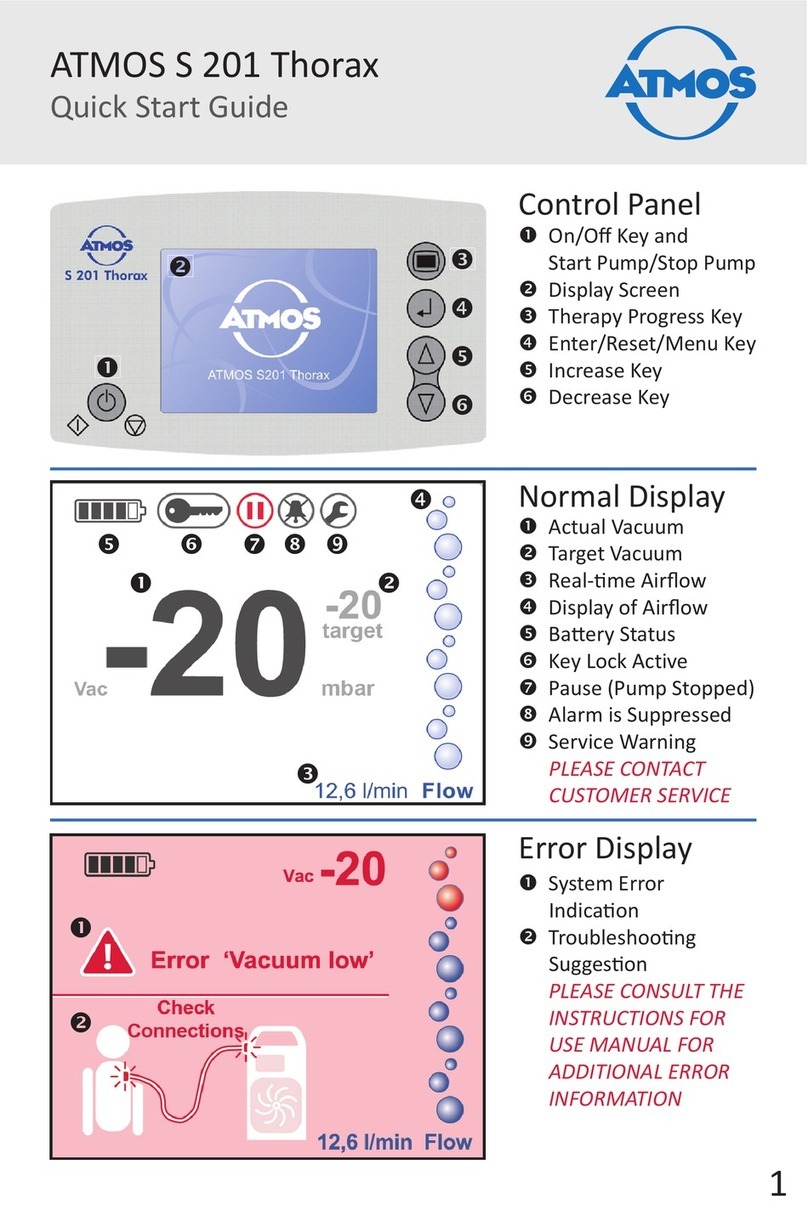
Atmos
Atmos S 201 Thorax User manual

Atmos
Atmos Chair 21 P User manual
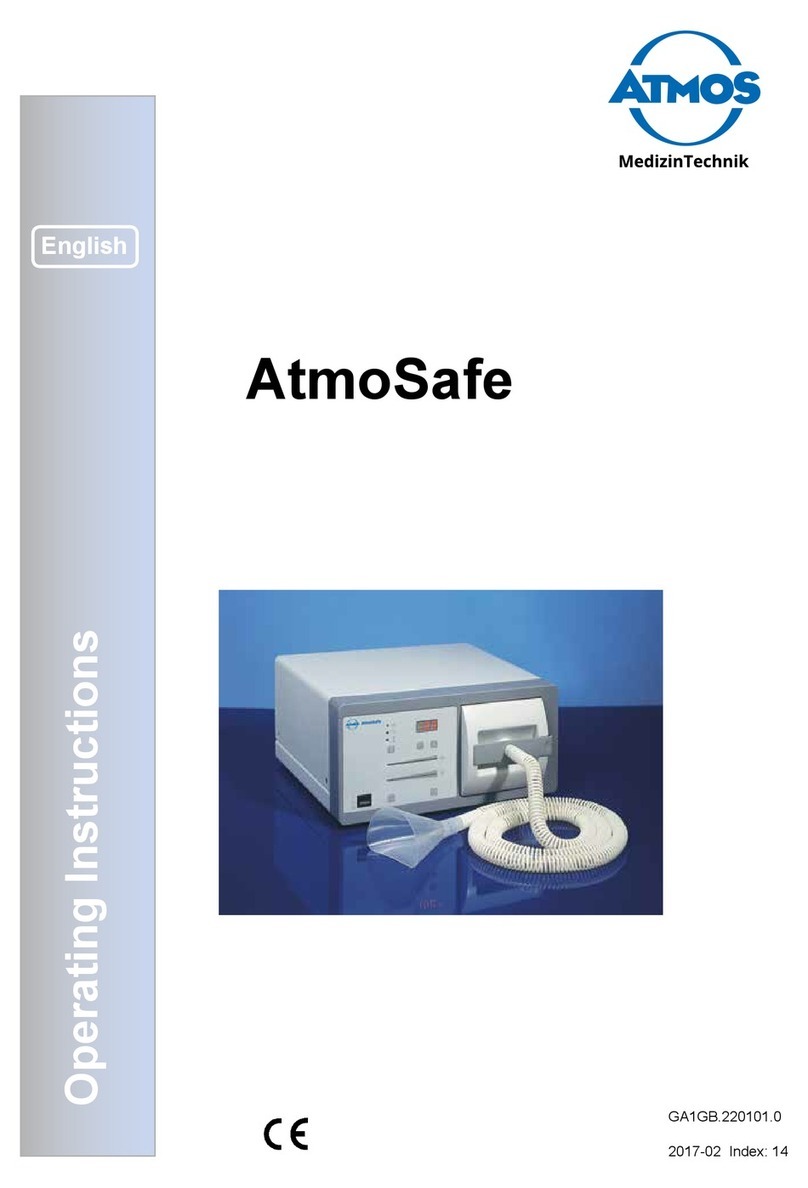
Atmos
Atmos AtmoSafe User manual
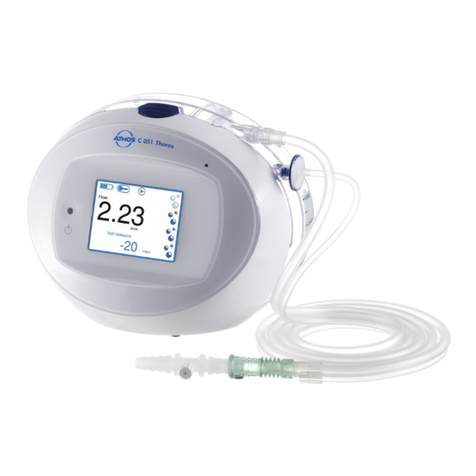
Atmos
Atmos C 051 Thorax User manual
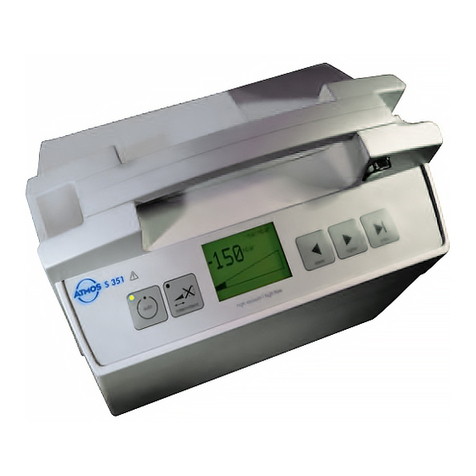
Atmos
Atmos S 351 User manual

Atmos
Atmos Scope User manual
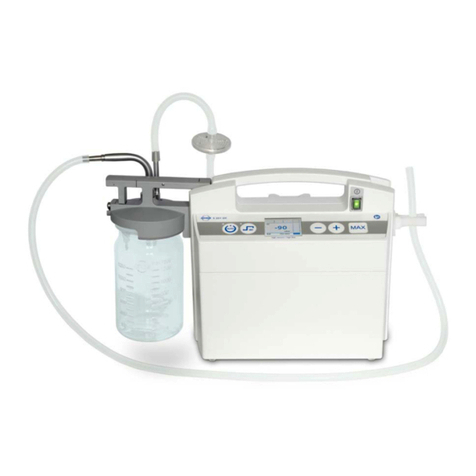
Atmos
Atmos S 351 OT User manual
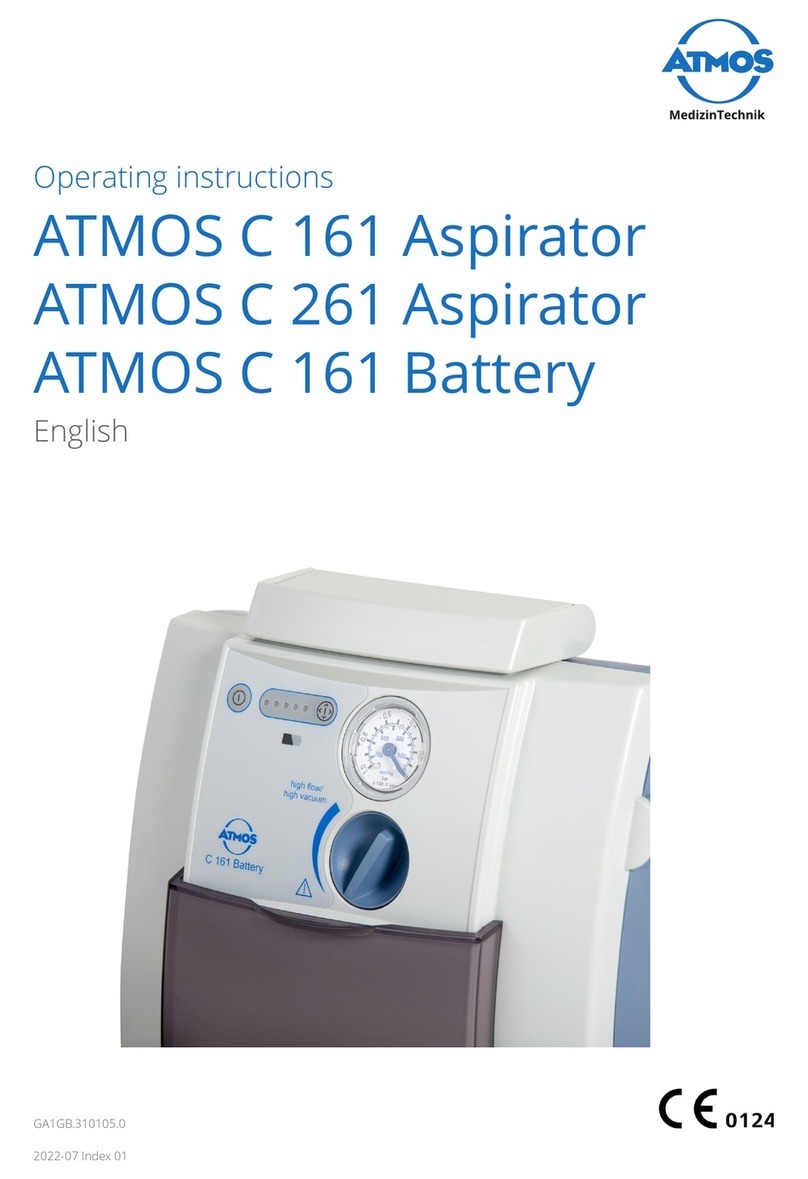
Atmos
Atmos C 161 User manual
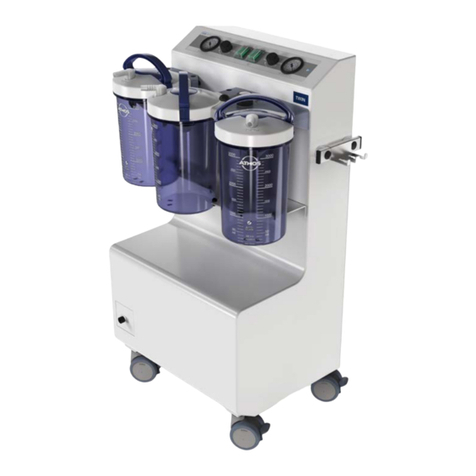
Atmos
Atmos Twin Record 55 User manual
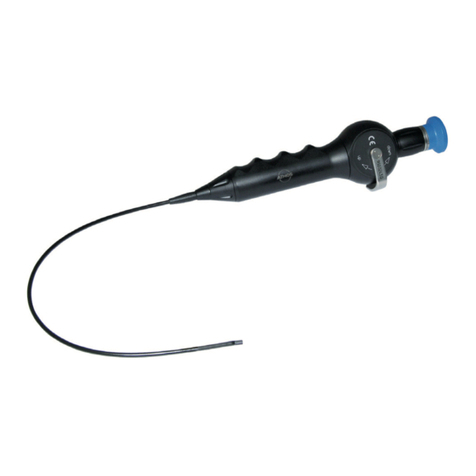
Atmos
Atmos ENT User manual
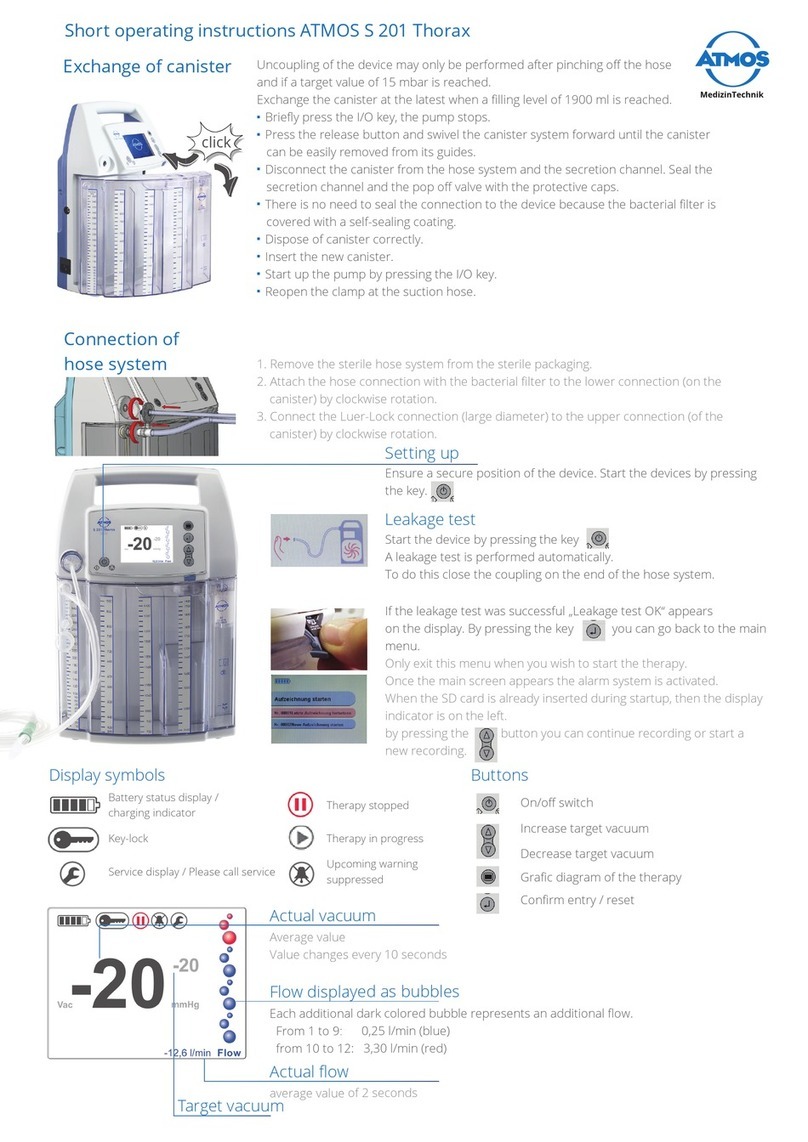
Atmos
Atmos S 201 Thorax User manual
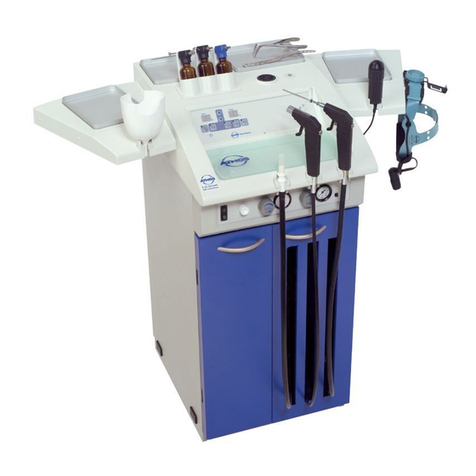
Atmos
Atmos S61 Servant User manual
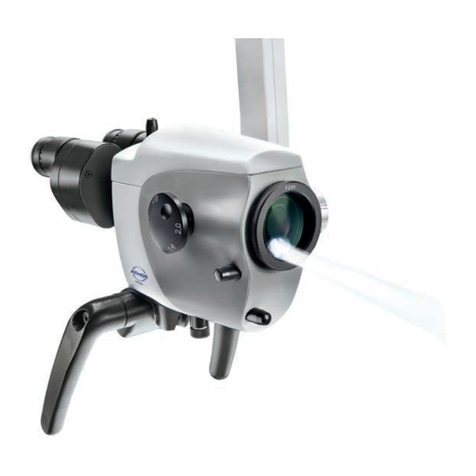
Atmos
Atmos i View 21 User manual
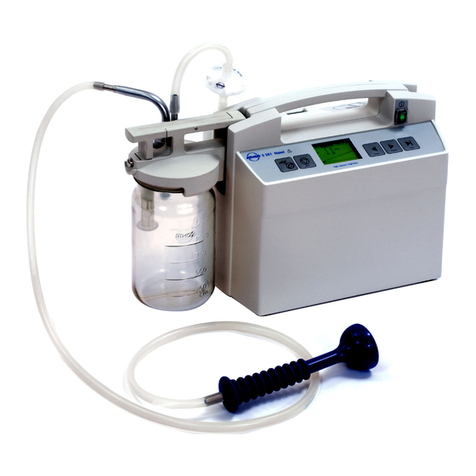
Atmos
Atmos S 351 NATAL User manual
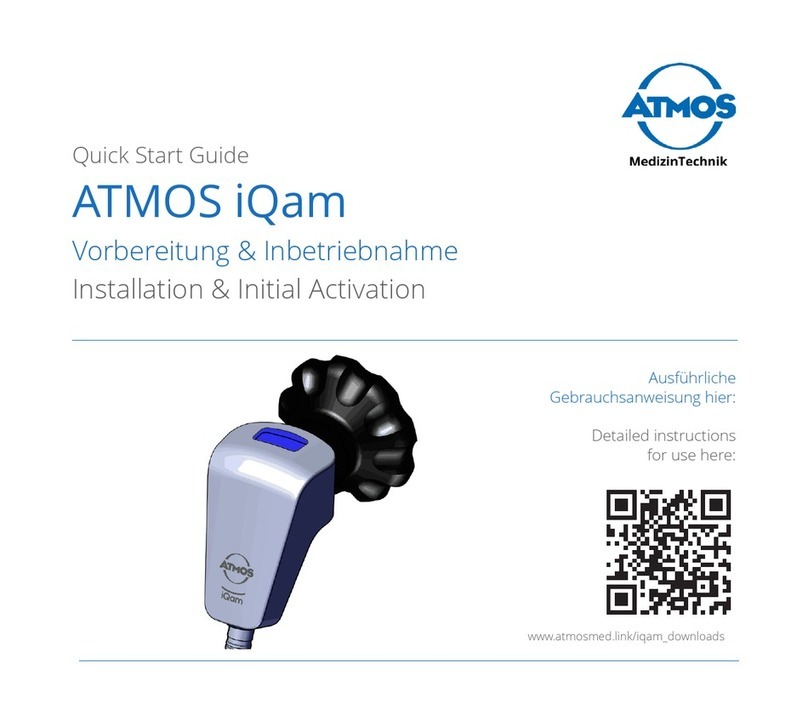
Atmos
Atmos iQam User manual
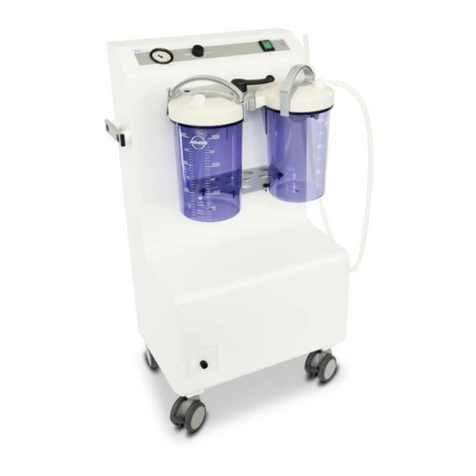
Atmos
Atmos Record 55 DDS User manual

Atmos
Atmos S61 Servant User manual

Atmos
Atmos C 161 User manual
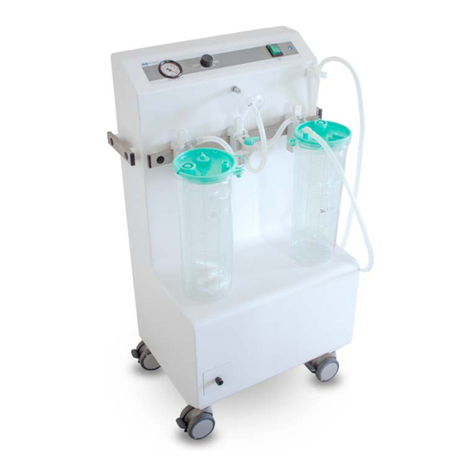
Atmos
Atmos Record 55 User manual
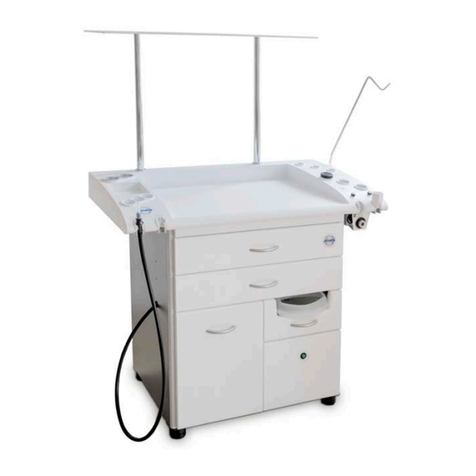
Atmos
Atmos C 11 Systema User manual
